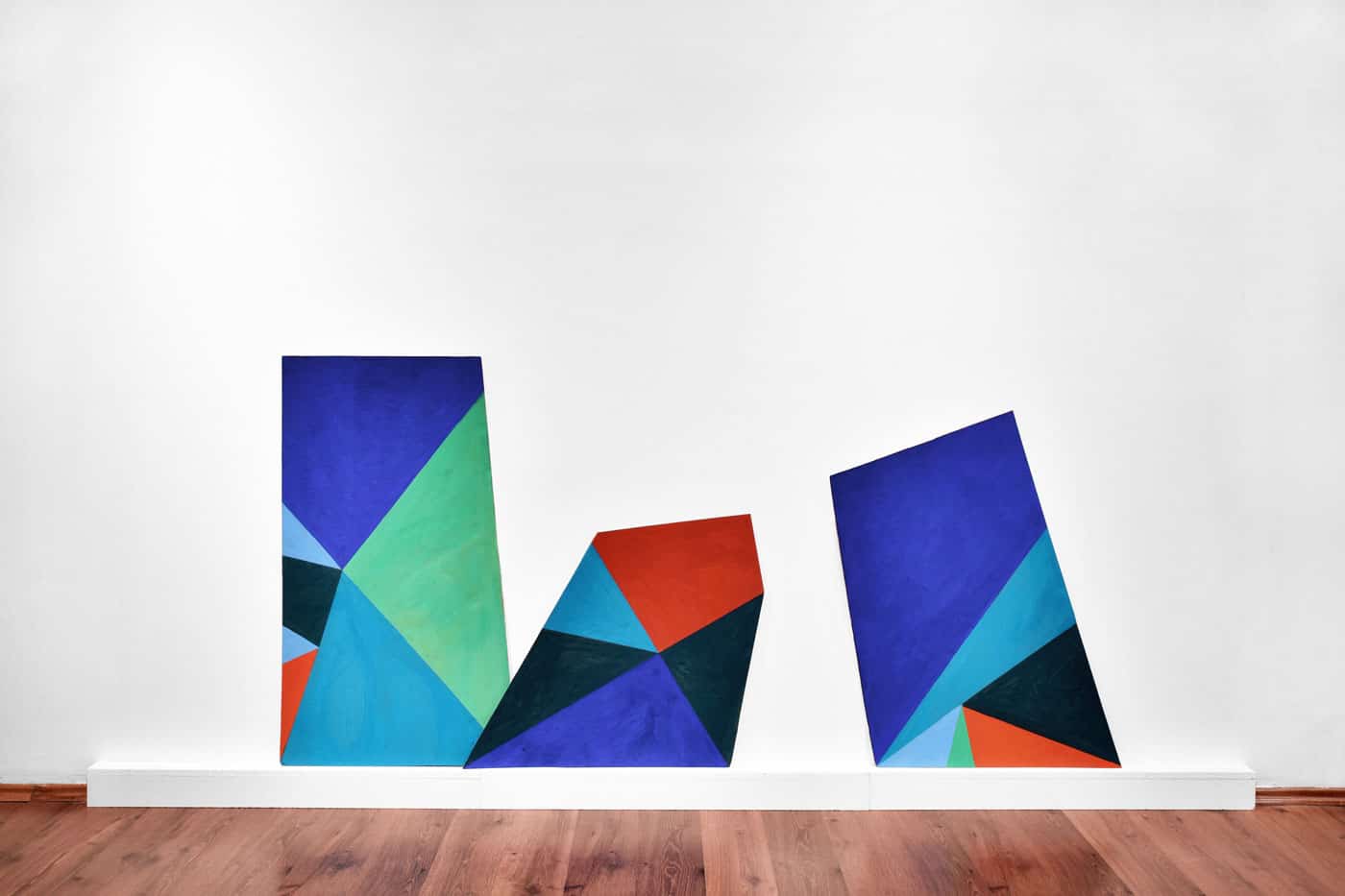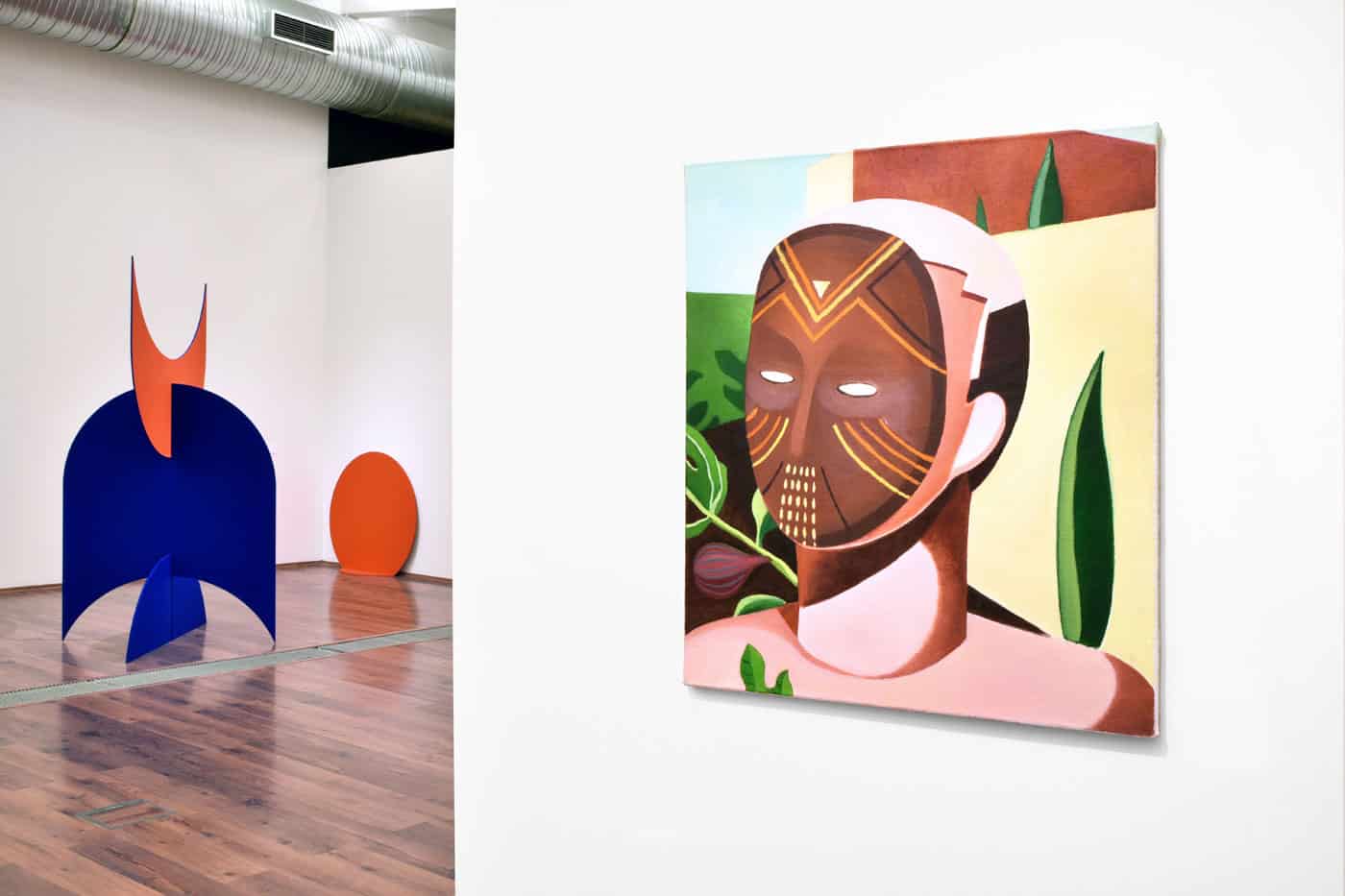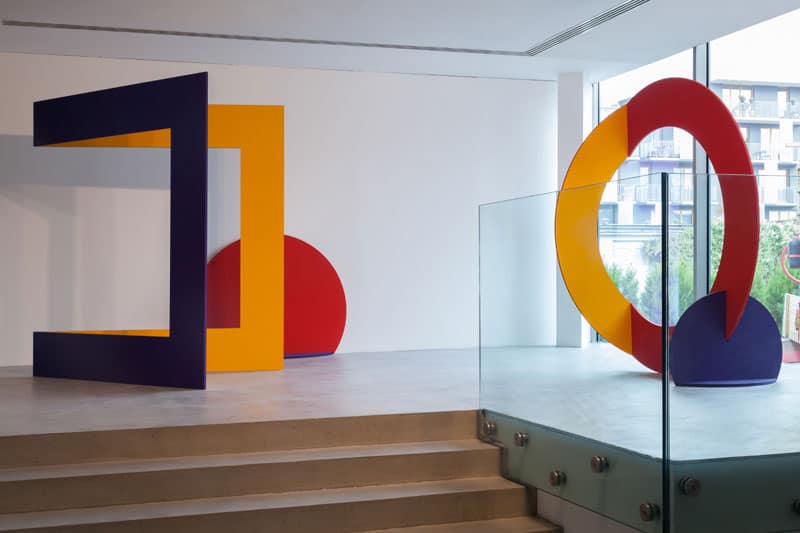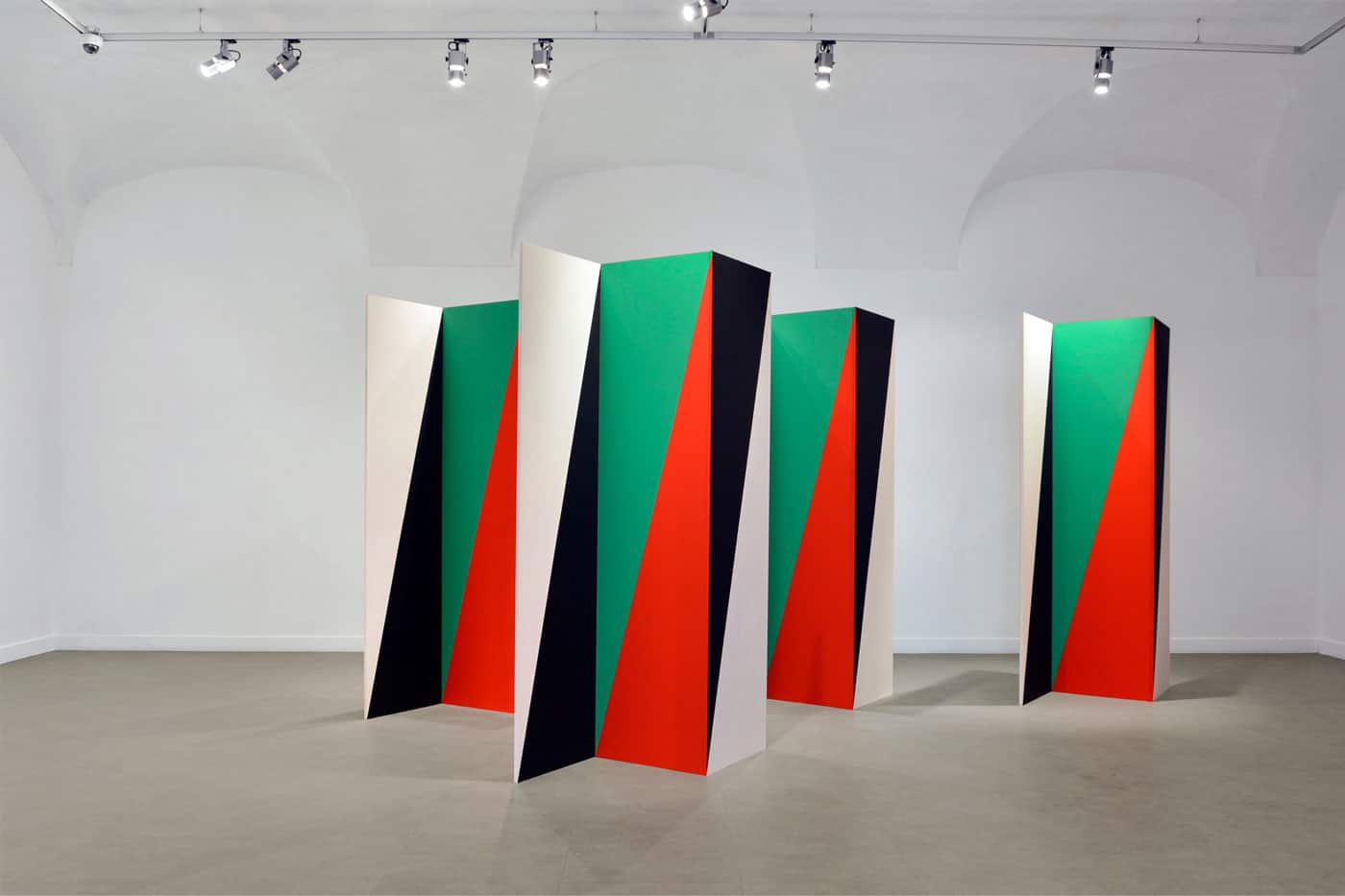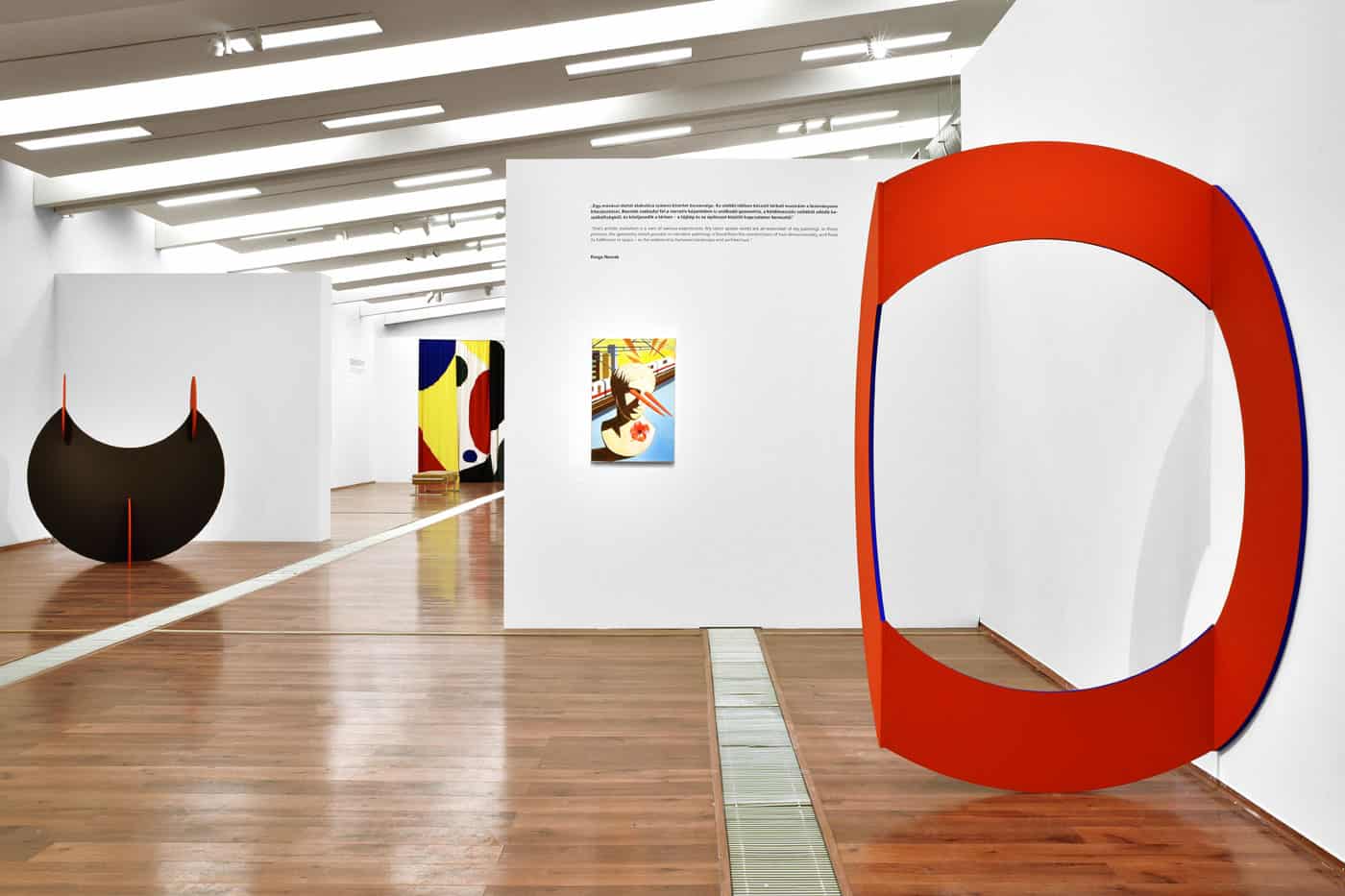MODEM, Kinga Nowak, Dramaturgy of Space, photo Lukács Tihamé
The following interview was conducted on the occasion of the artist’s solo show “Dramaturgy of Space” at the Modern and Contemporary Arts Center (MODEM) in Debrecen, Hungary.
Agnieszka Jankowska-Marzec: How did your collaboration with MODEM come about?
Kinga Nowak: Last year, Ábel Kónya, MODEM’s chief curator, put forward the idea of my solo show as he orchestrated the “XY” exhibition featuring paintings by young emerging artists from Poland and Hungary. Ábel is quite familiar with the Polish art scene, since he used to study here. Perhaps my three-dimensional objects intrigued him which, on the one hand, stand in stark contrast to my paintings while, on the other, are a natural extension and synthesis of the techniques I use on canvas. In his mind, the exhibition’s goal was to juxtapose my objects against the paintings.
AJM: There has to be something more to Ábel Kónya’s decision to stage your show in this particular institution than just his own personal sentiment.
KN: The exhibition programme at MODEM was largely focused on theatre in the last six months of 2017. Multiple works of Géza Blattner, the Debrecen-born pioneer of puppet theatre called Arc-en-Ciel., which was founded in Paris in the 1920s, were put on display alongside some of the art works made by his close friends and collaborators – scenographers, painters, photographers and designers. Ábel curated this enormous show and wished to follow through and organise another exhibition that taps into the dramatic potential of MODEM’s space.
MODEM, Kinga Nowak, Dramaturgy of Space, photo Lukács Tihamé
AJM: The eponymous dramaturgy of space refers to the three-dimensional nature of both art shows, Géza’s and yours. But it seems to me that the correlation between you two goes much further. Géza, for instance, draws upon African puppetry and Japanese shadow theatre.
KN: Similarities are ample. My paintings often portray inherently theatrical components, such as stage, masks, curtains and scenic design. Clearly, I’m also inspired by the artistic tradition in Africa. What is more, one of my works included in the exhibition entitled “Nagie ściany są piękne” (“Bare walls are beautiful”) depicts shadows made on the painting’s surface by the forms placed between the said surface and the source of light.
AJM: Could you please tell us more about MODEM itself? According to its mission, the center holds exhibitions of the most prominent Hungarian artists of the twentieth century, as well as contemporary art.
KN: MODEM presents both modern and contemporary art. International shows are complemented not only by the education programme, but also by numerous discussions, meetings, lectures, performances, theatre and dance plays. The institution has indeed a lot to offer. Upcoming art shows include solo presentations of art works by Gyuai Varnai, who represented Hungary at this year’s Venice Biennale, and Heri Dono, a painter and installation artist from Indonesia whose Pavilion at the 56th Venice Biennale (2015) had a striking theatrical and dramatic quality to it. Ábel Kónya is an unquestionable tour de force, spiritus movens if you will, of the institution. He’s the one who curates exhibitions and oversees MODEM’s elaborate programme of lectures, meetings, panels and workshops. His unbelievable energy galvanises everyone into action, encourages free and creative thinking. No wonder this place is always teeming with activity.
MODEM, Kinga Nowak, Dramaturgy of Space, photo Lukács Tihamé
MODEM, Kinga Nowak, Dramaturgy of Space, photo Lukács Tihamé
AJM: Did you have any idea about the Hungarian art scene prior to your visit?
KN: Currently, every art scene is incredibly volatile, so I prefer to follow the latest developments on Instagram. Besides, I believe only insiders can gain a greater understanding of its internal processes. However, I’m very pleased to have accidentally discovered photographs by André Kertész when I attended Blattner’s exhibition. Dóra Mauer’s art mesmerised me. The influence of her experimental art practice is clearly palpable among today’s artists.
AJM: And judging from the names you’ve just mentioned and my own experience with curating the Polish-Hungarian exhibition, which opened last year at the Polish Institute in Budapest, I must say at the risk of sounding superficial that abstract art seems to be doing very well in Hungary.
KN: I couldn’t agree more. At the moment, abstract and avant-garde art enjoys immense popularity in Hungary. István Haász, the epitome of a mature abstract artist, opened my solo show in MODEM. He seemed slightly confused by the fact that I’m far from an “inbred” abstract artist.
MODEM, Kinga Nowak, Dramaturgy of Space, photo Lukács Tihamé
AJM: Is your exhibition a retrospective, then? Don’t you think it’s a bit too early for an artist in their forties to hold such a commemorative event or is it in fact the opposite?
KN: To consider my exhibition a retrospective would be a gross exaggeration. We simply focused on tracing the origins of my art installations back to the paintings on canvas and cardboards. The curator’s intention was to present them in a broader context instead of lumping together some of my latest works. Personally, I found this transition quite intuitive and seamless. Nonetheless, I was looking forward to seeing them all together, placed side by side in a shared space for the very first time. The majority of paintings were placed in various collections, so we had to borrow them from a number of institutions in Poland.
AJM: You were pigeonholed as a member of a generation of young figurative artists from Kraków. Currently you seem much more interested in abstract art. How did you reach this conclusion?
KN: Figurative painting has affected my art practice and myself, which by no means suggests that I’ve rejected the possibility of working across different mediums and disciplines at some point. The artist’s progress is the sum of their experiences. A division into artistic disciplines is still cultivated. In 2014, my works were featured in the book “100 Painters of Tomorrow,” the publication of which coincided with me gravitating towards spatial objects. Numerous concepts for paintings I still harbor are overpowered by my need to toy with perception and, more importantly, to reconcile and examine the relations between different space, architecture and landscape components. Contrary to an actual execution of ideas, a period of transition lasted awhile. Eventually, I succumbed to the temptation to abandon representation altogether, which had been brewing in me. A geometry intrinsic to narrative imagery has clearly transcended two-dimensional form of expression. My work method has also changed. Now, I work fast; go into the studio without a premediated plan of action. I don’t know what’s going to happen. The result often surprises me.
MOCAK Museum of Contemporary Art in Krakow, Kinga Nowak, Artists form Krakow The Generation 1970-79, photo Rafał Sosin
AJM: What’s your opinion on the so-called new formalism popular especially among students and recent graduates of art schools? Do you subscribe to its underlying principles or remain rather skeptical towards the phenomenon?
KN: The movement has already conquered the international art market. It was only a matter of time before it’d reach a local scene. New formalism has risen like a phoenix from the ashes of minimalism and it’s soaring high right now. I’m not particularly fond of making generalisations about art movements; so allow me to consider each artist on an individual basis. My observation of the latest tendencies in contemporary art is always accompanied by the return to the source: Aleksander Calder, Daniel Buren and Ellsworth Kelly. Occasionally, members of the Kelly Foundation and I exchange messages on Instagram. Their encouragement to make larger versions of certain projects has bolstered me up and strengthened my conviction that everything I do is really worth something. Then we have the hard-edge painting movement in the US, the major representatives of which include Ellsworth Kelly, Leon Polk Smith and Carmen Herrera, whom I’ve recently discovered. This approach to painting refers to one’s perception and contemplation of nature. I find it hard to believe how I could’ve ever failed to decipher the language of abstraction.
AJM: What are your thoughts on the avant-garde? Do your attempts to engage in a dialogue with the avant-garde artists spring from your fascination with the conceptual or formal aspect of their practice?
KN: It took me a while to fully comprehend the avant-garde movement. Its obscurity and gaps in my academic knowledge hindered any pursuits of my interest in the avant-garde despite the fact that its tradition manifests itself clearly in case of for example, the First and Second Kraków Group or Cricot 2. Back then, I decided to swim with the tide and opted for representation. In the interview conducted by Adam Mazur for SZUM Magazine, Jarosław Suchan pronounced contemporary society as ill equipped to interpret avant-garde art. He’s absolutely right. It goes without saying that Katarzyna Kobro’s sculptures should be out there, on the streets and squares of the city. What a majestic sight it would be to behold. The avant-garde fosters the development of children’s taste and a different kind of aesthetic sensibility. Form used to embody bold ideas. Now, there’s no place for ingeniousness. Society lacks proper tools to reinvent the world around it, as Maga Ujma mentions in her curatorial statement to my exhibition. Apparently, we have a lot of catching-up to do and I’m afraid the situation is beyond remedy judging from the dire condition of today’s urban landscape.
lokal_30, Kinga Nowak, Quite possible, photo Marcin Liminowicz
AJM: Your focus seems to have shifted primarily towards an investigation into the notion of space. The most recent exhibition of your works features a curtain and some of your paintings, such as “Zanurzenie” (“Submersion”) and “Instrument” (2013) that had already heralded the imminent “theatrical shift.” Have you ventured into the experimental scenic design of sorts in order to free yourself from the constraints imposed on you by painting’s flat surface and frame?
KN: My paintings often feature recurring motifs related to theatre, while the scenes I choose to portray bring stage plays to mind. Therefore I’m convinced of a continuity and coherence in my creative process. The curtain had been incorporated into my pieces until it was finally elevated into the piece itself that you supposedly could’ve been transported into through a secret passage hidden somewhere in the bundle of fabric. Textiles imply femininity and embellishment, the act of covering and uncovering. It’s a tangible, haptic material. Sarah Crowner made an excellent piece out of a curtain involving a dance performance that made explicit reference to the avant-garde and Maria Jarema, in particular. I was transfixed by its open composition and fluidity of fabric, so I decided to take on a textile medium myself for the first time, which posed quite a challenge. I don’t think painting impedes my progress in any way. I just have a propensity to question the creative status quo. You should always feel at liberty to do anything that feels right in the moment.
AJM: Is the division of applied (design) and fine arts (painting) justified taking into account the nature of your art practice? Has a distinction between art disciplines already been rendered obsolete?
KN: These are corresponding disciplines that have always penetrated and influenced one another. Needless to say, the greatest works of art and design manage to get the best of both worlds. Let me ask you this, do you reckon the ceramic vases by Betty Woodman to be flower containers, sculptures or paintings? Anachronistic divisions breed conflict. It’s a natural human tendency to split things into categories, establish hierarchies and deem something more worthy. I have no qualms about crossing the boundary between art and design. In the 1990s, I used to live in Düsseldorf, a former fashion capital in Germany. I strolled down the Königsallee to mainly admire the designs by Jil Sander who created a minimalist and sophisticated silhouette of a modern woman. Her fashion lines have stood the test of time. I still view her inspiring and original designs in terms of sculpture rather than clothing. Furthermore, seminal visual artists often engage in collaboration with Maharam, a New York-based textiles creator. The applied and fine arts are strongly intertwined and you shouldn’t let some labelling prevent from creatively teetering on the brink of both fields.
Galeria Biała, Kinga Nowak, Polish Forest, photo Michał Bratko
AJM: Your paintings are permeated with the spirit of highbrow culture, art history and “classicism.” Even the titles of your works point at your expertise. What spurs you on to probe archeology and anthropology in relation to your art?
KN: It might be a sheer form of escapism from the real world into the South where the sun always shines high and bright on a clear sky. Over there, shadows almost fade away, which triggers my imagination. I don’t know, maybe that’s the reason why I feel drawn to classical art. I enjoy constructing universal narratives, surrounding myself with the intense colour and light I miss in Poland. My protagonist is the archetype of Odysseus, a classical vagabond, traveller, stranger, emigrant even. As opposed to painfully prosaic vacations, classicism is filled with pathos. I’m captivated by the dichotomy between the transient/ephemeral and the permanent/immutable.
AJM: What’s the difference between the status of the artist today and when you were just starting out? What has changed?
KN: The Internet changed everything. Instagram has extended the range of artist’s visibility in the public eye, provided them with the platform for exchanging views and receiving feedback on their work. Obviously, a total of your likes reflects merely a certain social convention, but I’m always pleased to get comments from foreign artists or institutions. They delude me into thinking that the art world’s capitalist hierarchy might soon be abolished.
WIDNA, Kinga Nowak, Forms of imagination, photo Michał Bratko
AJM: Over two years ago, you and Michał Bratko decided to open the Widna Gallery, an artist-run-space in the Grzegórzki district of Kraków. What did you hope to achieve?
KN: Our aim was for us to simply become the active participants of culture. We wanted to make our own contributions to the contemporary art scene in Poland rife with riveting iconoclasts. Though running on a shoestring budget, the alternative exhibition spaces offer much greater flexibility and independence to artists than mainstream cultural institutions. Therefore they never shy away from the challenges and risks involved in presenting a bigger picture of the art world.
AJM: You have quite an intense year behind you. What’s next for you, creatively speaking?
KN: Last year, I implemented a number of fascinating art projects while producing new works commissioned for four large exhibitions. I collaborated with Zofia Małysa on the “Side effects” exhibition in BWA Contemporary Art Gallery in Katowice; with Magda Ujma on the “Polish Forest” exhibition in Biała Gallery in Lublin; with Monika Kozioł and Delfina Jałowik on the art project in MOCAK; and with Agnieszka Rayzacher on the “Quite Possible” exhibition in local_30 in Warsaw. Currently, I’m working on my upcoming exhibition in Budapest curated by Fruzsina Kigyós entitled “Cult Created Art, Art Created Division of Labour,” May-June, 2018). The project, which utilises both light and shadow, is also closely connected with the world of theatre.
AJM: Thank you for the conversation.
Kinga Nowak studied painting under the tutelage of prof. Jacek Waltoś at the Academy of Fine Arts in Kraków, graduating in 2001. In the years 2000-2001, she participated in the Erasmus student exchange programme and attended the École Nationale Supérieure des Beaux-Arts in Paris on a scholarship she received from the French government. She’s been running a painting studio at her alma mater since 2002. She was awarded her PhD in 2007, and received her degree of doktor habilitowany (post-doctoral degree) in 2012. Kinga Nowak is a figurative and landscape painter who has recently branched out into creating abstractions and spatial art installations drawing on the tradition of modernism. In her art practice, she explores a wide variety of subjects, including motifs from everyday life, fantasies, myths, art history and European culture.
MODEM, Dramaturgy of Space, photo Lukács Tihamé
Kinga Nowak
“Dramaturgy of Space”
18 February – 31 March 2018
curator: Ábel Kónya
MODEM – Modern and Contemporary Arts Center, Debrecen, Hungary




